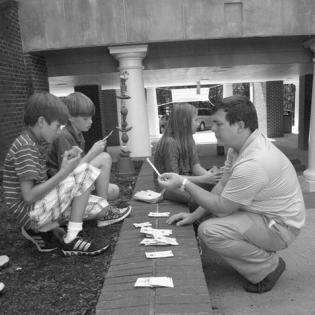Back-to-Back Builder
We work on communication and listening skills while designing and building simple objects. This helps us think about the power of words and how difficult it can be to get a message across to another person without it being lost in translation.
Author: Urban EdVenture Faculty
To carefully craft words to get more accurate information to their partners to complete a task together.
Any sort of readily available building materials, such as straws, Popsicle sticks, toilet paper rolls, books, pencils/markers, Legos, blocks, tissue boxes. Alternatively, use geometric shapes (four lines, two circles, etc.) to draw the construction
The most important thing is that the Architect and the Builder need to have matching building sets so they have the same materials from which to choose.
Review the instructions and gather building materials for the activity. Separate materials so that each Architect and Builder(s) pair/group has matching building sets.
This may be done virtually through technology. The Builder and Architect should not be able to see what the other is doing on camera.
Debrief as a group or have participants quietly reflect on the experience through writing about the following questions:
- Which role was the most difficult for you? Why?
- Which round was most successful for your group? Why?
- What were the specific methods you used to accomplish your task?
- How does this activity relate to working with a community partner?
Instructions
Put the participants into pairs (or threes). If you are working virtually, make breakout groups of 2-3. For a group of three, they rotate through the roles and have two different Builders during each round.
Have the pairs sit back-to-back (we do this on the floor) so that they cannot see each other's work. If virtual, they do not allow the camera to see the building site.
One person takes the role as the Architect and gets 2 minutes to build a design that they will then have to describe to the Builder. The Builder gets two minutes to replicate the Architect’s design as the Architect describes it to them.
Repeat this in three rounds with alternating roles in each round. The rounds go as follows:
- Round 1: The Architect speaks and the Builder is silent
- Round 2: The Architect speaks and the Builder is allowed to ask yes/no questions
- Round 3: The Architect and the Builder are allowed to speak freely to one another
Hand out building materials and begin the activity. If working virtually, make sure all participants have the building materials, put the directions for the three rounds in the chat box, and send them to breakout rooms, coming together between rounds, if desired.
Reflect on the experience of being Architect and Builder. What did they learn about effective communication?
